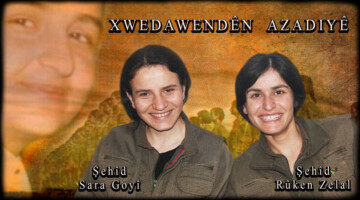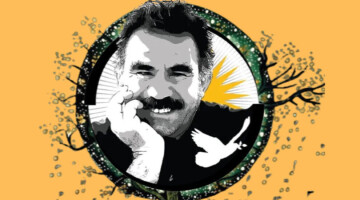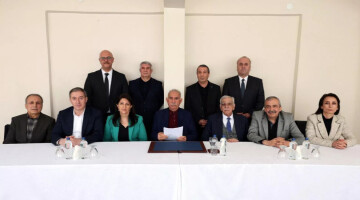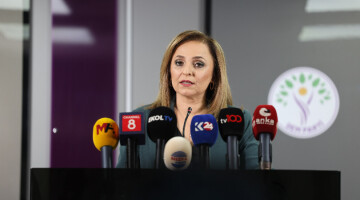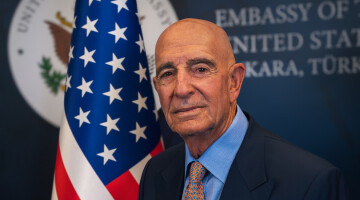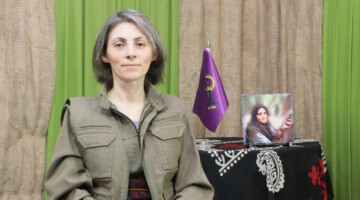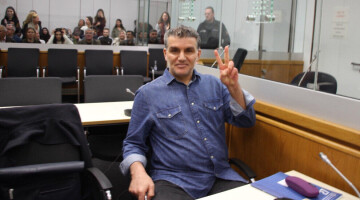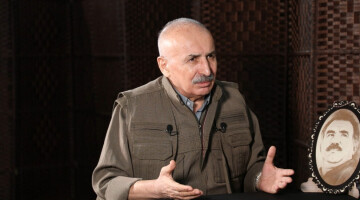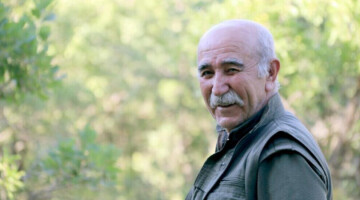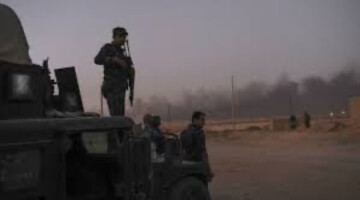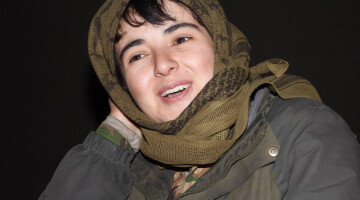The reasons for the uprising of the last five days against poverty, unemployment, high cost of living and the repressive policies of the Islamic Republic of Iran are discussed differently by various sides. We asked our editor for ANF-Farsi (Persian) service, Karwan Hewram about his assessment.
* For a long time it was quiet in Iran. But in the last five days, actions have begun in the city of Meshhed that have spread to all of Iran and Rojhilat. Let's start with a very general question: what is happening in Iran?
The despotic regime in Iran has been oppressing the population for many years. In recent years, this regime has been working hard to ensure that the peoples of Iran are not aware of the current phase of change in the Middle East. Apart from the Kurdish people, who were strongly motivated by the revolutionary processes in the other parts of Kurdistan, all political demands of the peoples of Iran have been suppressed. There is nothing left in Iran that can be called an opposition. From the Greens to the Socialists, from the Democrats to the real reformers, they were either exiled or thrown into prison.
In Tunisia, Egypt, Libya and Syria, the despotic regimes faced a process of change. But so far Iran has been able to prevent this by leading this war outside. But both the international embargo, the regime's policy of oppressing the peoples, and the current economic crisis have reached a point where they cannot be endured.
* Is the slogan "Leave Syria, leave Lebanon, look at Iran!" chanted in the demonstrations, an expression of it?
Since the 1979 revolution, the Iranian regime has used the country's financial opportunities to spread its ideology to neighboring states rather than raising the level of prosperity in Iran. That's one thing. Another point is that when the demands for freedom, raising of democratic standards and legitimate rights came forward, the regime always portrayed them as a "play of external powers" and as a "incitement", and tried to suppress them accordingly. For example, they have doubled the defense budget for external operations and armament this year, while halving the budget for education, health and other needs. The public recognizes and experiences this.
* You said that the Iranian regime calls the actions "incitement" and "organization of foreign powers". But other forces are trying to portray the actions as a settlement of account between two power blocs in Iran. Which of these is right?
It is true, there is a crisis in Iran's system. So far, those in power have denied that. But it's very hard to deny that today. There have been elections in Iran and the people have given the reformists another chance. This opportunity was given in the hope of change and Rouhani was brought to power. But it became clear that Rouhani is also part of this system. For example, 55 percent of Iranian society is female, but there was not a single woman minister in Rouhani's Cabinet. Iranian society consists of 50 percent non-Persian peoples, Kurds, Azeris, Balochis and Arabs, but not one of the Ministers in the Cabinet is from these groups.
* The process of cabinet building alone was painful. Rouhani first introduced his cabinet to the religious authority of Khamenei before the parliament, overcoming the issues with the Pasdaran. Iran's system of government is a bit confusing for outsiders. Who is who in the Iranian government system?
Well, a person or institution that wants to do politics in Iran has to accept the terms of the religious council of experts, which is directly affiliated with Khamenei and whose members are appointed by him. In the 40 years since the revolution in Iran, everything that needs to be done is aligned with the interests of the revolution. At the center are the conservative hardliners based on Khamenei and the Pasdaran (Iranian Revolutionary Guards) and the reformers who claim to be a little more tolerant. The reformists try to keep the hopes of the people in the system. To deceive the population, democracy is played.
For example, Mihemed Khatami was a reformer. He was in power for eight years, and that was the time with the biggest repression. For example, one morning he got up and closed 79 newspapers and magazines, just like Erdoğan does in Turkey today... They murdered dozens of journalists. Afterwards, Mahmoud Ahmadinejad was brought to power by the Conservatives as President of the Republic. They had called him Khamenei's brother in spirit. But he is the main culprit in the murder of thousands in Iraq and Rojhilat. He destroyed all relations of Iran with the world, but in the direction of the desires of the system. Next to him, for those who dislike Ahmadinejad, they introduced Ruhani, saying that he is more moderate.
* As for today's protests ... Demonstrations began in Meshed, hometown Khamenei. When there were protests by reformers in 2009 after the elections, this city positioned itself on the side of Khamenei in which there were counter-protests. Also in Kum, a symbolic city of importance for Shiites, demonstrations are taking place, as well as in Isfahan, which Iranians proudly say is “the half of world”. How should this be understood, also with regard to the spread of actions?
This is the first time in the history of Meshhed since the Islamic Revolution 40 years ago that protests at this level take place in this city known as the Fortress of Persian Nationalism. True, these are all symbolically important cities. Kum is certainly one of the symbolically most significant places. Isfahan is protesting and Isfahan is known as the unofficial capital of Iran. This indicates that society is no longer able to endure the current system and government. Already after the revolution it was given only about 30-40 years in this condition. Society just cannot stand it anymore.
Let me give an example: The budget for the mullahs within the Iranian justice system is three times higher than the budget of all other legal institutions. According to a study, to feed a family of four in Iran with solely bread and water for a month, is equivalent to $ 125. But in Iran, millions of people do not even have a job to earn this amount. In addition, millions of dollars are sent each month for the war to Syria, Lebanon and Yemen. They cause the death of thousands of people in these countries, but people in their own country are hungry. There was an earthquake in Kermanshah, the state did not help, and it confiscated the aid that came from other countries. After the earthquake in Kermanshah, about 20 people committed suicide. Why? Despair, poverty, homelessness, hunger... What else do such a people have to lose? That is why they chant slogans such as "Death to the regime", "Death to dictatorship" in their demonstrations.
* There is also a debate about whether these protests have economic or political causes. What do you think?
At the beginning of the protests mainly slogans with economic demands were chanted. But it is already part of the Iranian regime’s policy to discipline the population through hunger. We cannot separate economy and politics. In addition to hunger, the regime in Iran has left no trachea through which society can breathe. There are no political parties, no intellectuals, no social rights, no women's rights, no future for the youth, no rights for the peoples. That's all politics.
* As a journalist who has been closely monitoring the Iranian system for many years, what do you think is the main difference that separates these protest from previous ones?
Such protests also took place in 2009 and also against the Khatami government between 1997 and 2005. At that time, the pioneer of demonstrations was youth and, above all, students. The protests were limited to Tehran. But now protests erupt in cities like Meshed, Kum and Isfahan and are increasingly spreading to all cities of Iran. The people who are leading the protests the are poor, unemployed and young. Women also take to the streets. Housewives are on the street and say they are not going home. That is why the uprising is often referred to as "Înkilabî Gorisnegan" (The Revolution of Hunger).
Another difference is that in the past there were demonstrations of the reformists against the conservatives or the military. But the actions are now directed against the reformists. Because the reformists have cheated society. The reformists have been doing this for 20 years. Each time they get the votes and sell out the people's hopes to Khamenei and the military.
* So, is it the main difference that today’s protests are against both the reformers and the conservatives?
Indeed. The society now knows very well that the reformists and the conservatives are two players in the same game. In this regard, it is worth taking a look at the slogans: "Death to the dictator", "Death to Rouhani", "Death to the Islamic Republic", "Death to Hezbollah" is called. Society is now aware that reforms will not change the system.
* Do you think the protests will continue?
If the regime attacks the people, then people will not take a step backwards. They have tried to be a bit cautious so far. They can also see that this anger has been dammed up for 40 years. Yes, the revolution was right, but the results were not. The revolution has been stolen. People now want the revolution back from the mullahs and correct the mistakes. People want to take responsibility and leadership.
* Who can take the leadership of the revolution?
This is the task that falls to revolutionaries abroad, intellectuals, the general public, young people, women and all components of society. But if you do something, you have to learn lessons from the mistakes of the past and take on this task without expectation of outside intervention.
* When talking about organized struggle in Iran, Kurds are the first to come to mind. How do you see the possibility of uniting the Kurdish opposition with the Persian, Arab, Balochis, Azerbaijani and other social dynamics? Can they come together or will it be like after 1979?
After the revolution of 1979, the center of all leftist, socialist and communist parties was in Sinê [in Rojhilat]. Apart from the Kurdish parties, these parties saw Sinê as their center. This is a deep legacy. So it's nothing new. This heritage can bring the revolutionary and democratic forces together. It is a common legacy. On the other hand, the Kurdish people are a politicized society. So it is in Rojhilat, too. They are the most politicized people in the Middle East. It also affects other peoples. The only reason why the Iranian regime is this much against the Kurdish people in Rojhilat is that it does not want them to be politicized, but to be depoliticized. But for the Kurdish people, politics is more important than bread and water. For example, in Meshed's protests, the slogan "death to inflation" was called, while in Kermanshah "freedom for all political prisoners" was chanted.
* Can the two slogans unite?
Definitely. Because the people of Iran have an experience of co-existence for thousands of years. They have a great heritage. Shoulder to shoulder, they have brought down dozens of dictatorships. There have been dozens of successful revolutions. If the revolutionary forces and leaders can come together with a democratic program, if they remain loyal to the people, then there is no reason why they should not be successful. The people also want it. For example, a slogan chanted by demonstrators was: "Do not be afraid, do not be afraid, we are all together". That's a message. All forces that want a people's revolution should come together and move forward together - that's the message.

